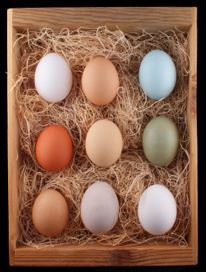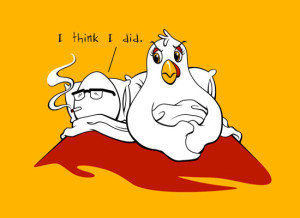Hen Herald Update
The Hen Herald wishes to apologize AGAIN, for taking so long to get this issue out after the strike. The staff decided to go on vacation in order to smooth the ruffled feathers that emerged during the heavy strike negotiations between the management and the riffraff. For our team re-building vacation, we chose a cruise to Alaska, where we were pretty sure we would not see too many live chickens, which we all needed a break from. However if you think that no one keeps chickens in Alaska you would be wrong, the Hen Herald’s source (Google – “chicken keeping in Alaska”), confirms that some people do. So not only are Alaskans watching Russia from their back yards, but a few have chickens to watch too.
To try to reduce the large number of complaints to the editor (one so far) about unreliable Hen Herald delivery, the Hen Herald is offering to all subscribers two free HH issues added onto their current subscriptions. All further complaints will be directed to our new Customer Service Department (our circular filing cabinet located under the desk).
Henny, Penny, and Sky
Last reported in the Hen Herald, Penny and Henny were starting to molt and were not laying eggs. We are happy to report that Henny has again joined Sky in egg production, and the two of them are egg-laying machines. Penny, in just the last week, may have laid an egg or two, but as reported by Denise “Their eggs [Penny and Sky] look so much alike that it is hard to tell for sure who laid what unless all three girls lay on the same day.” Most of Penny’s and Henny’s feathers are back in and looking good. Sky is showing no signs of molting, so it will be interesting to see if she lays all winter long.
The girls have been enjoying the summer with a lot of sunshine. As fall is upon us, Denise and Andrea have been harvesting their crops and then opening up the cleared vegetable garden areas to the girls, which the chickens love (reclaimed territory full of bugs and slugs that have not been plucked all summer). They are also getting a large variety of vegetables and fruits to eat from the garden plots.
The girls had one incident this summer that caused them concern and caused Andrea to come running to the backyard to see what was happening. Denise and Andrea’s neighborhood has a Cooper’s hawk that occasionally is seen swooping through the neighborhood after small birds. One quiet late summer day, Andrea was minding her own business when she heard the girls begin to alarm call all together. When she found them they were huddled up, very nervous, and still calling loudly. “It was pretty obvious that they were looking at the wooden fence, so I looked too and saw the hawk on the fence”. Andrea reports. “It made me nervous, so I shooed the hawk away, and put the girls in the run so they would feel safe.” A Cooper’s hawk is small and it would be very unlikely that it could do any harm to the chickens, but nervous and scared chickens do not always make smart choices when faced with a predator, so Andrea did the right thing to not take any chances.
Chicken Glands
Warning – some subject matter may not be suitable for all readers. Bird and human bodies have many of the same glands with the same purpose, which help the body to function properly. A gland is a group of cells that work together to produce fluids or hormones. A couple of glands in common are the salivary gland, which produces saliva in the mouth, and the hypothalamus gland, which produces hormones that affect the production of other hormones from other glands in the body.
Birds, including chickens, do not have sweat glands like humans do; therefore they must have other ways to cool off the body when it is becoming over-heated. One way for birds to cool off is to pant. On a hot day you will find that a lot of birds have their mouths slightly open and their throats will be rapidly fluttering as they pull air in and out over the moist membranes of their mouths and throats in order to cool off. Birds will also use any exposed skin such as their legs to help in the cooling process; blood flow to the legs can be reduced or increased depending on what the bird needs in order to remove heat from the blood. And a few birds, like chickens, have extra exposed skin that can be used to help regulate body temperature. On a hot day chicken waddles and combs become larger and redder as blood is shunted to these areas for cooling, in the winter the opposite will happen.
Uropygial, preening, or oil gland, is found on birds and has been compared to the sebaceous gland on humans and other animals. The sebaceous glands are microscopic glands in the skin that secrete an oily/waxy matter, called sebum, to lubricate and waterproof the skin and hair. The preen glands of birds appear to be similar in function to the sebaceous gland, but unlike humans, the preen gland of birds is found in only one location, on their backs at the base of the tail. To spread the oil over the body, birds must spend time everyday collecting the oil in their beaks and spreading it over their feathers and skin.
 Shell gland (also called the uterus, although not like the mammalian organ) secretes calcium and other trace minerals and color creating the hard shell of a bird egg. Any animal that lays eggs and needs to protect them from the elements has a shell gland – fish, reptiles, etc. It is common for the eggs to not be uniform in color; many things can go haywire as the color is laid down on the egg. Denise and Andrea claim that no two eggs are alike. “It’s like egg dyeing at Easter!” Denise exclaims.
Shell gland (also called the uterus, although not like the mammalian organ) secretes calcium and other trace minerals and color creating the hard shell of a bird egg. Any animal that lays eggs and needs to protect them from the elements has a shell gland – fish, reptiles, etc. It is common for the eggs to not be uniform in color; many things can go haywire as the color is laid down on the egg. Denise and Andrea claim that no two eggs are alike. “It’s like egg dyeing at Easter!” Denise exclaims.
Two of our readers have been reporting on the “practice eggs” their young hens have been laying. They were so excited to get their first eggs, the Hen Herald captured a few quotes such as “We got’em [eggs]! Chickens are WAY fun!” This reporter asked how the first eggs are looking; shape, color, texture. Young chickens need practice. “All have looked fine shape-wise and all the shells have been hard. Two of the girls lay a nice medium brown-colored egg. The third egg almost looks brown with a white overlay (making it then appear pinkish). I wasn’t sure at first if the ink jets in that chicken just weren’t working right yet for the shell color, but found on the internet that Buff Orpington’s can lay this color egg and we have one.” our reader replied.
The last gland we will report on is the Sperm Host Gland. A hen can store sperm for fertilizing her eggs for up to two weeks in a special gland in the reproductive system. It takes a hen about 20 hours to produce one egg from start to finish, and therefore, to produce a clutch of eggs for hatching chicks she has the capability of only breeding once with the rooster and then releasing small amounts of sperm for fertilization of each egg as it makes its way through her reproductive tract. Amazing!
Jumping Chickens, Oh My!
One of our readers happened to mention in an email to the Hen Herald that their chickens can jump and that they were thinking of training them to jump through hula hoops. The Hen Herald wasted no time or expense to get this exciting story. Our star reporter called long distance (free) to Pennsylvania for an exclusive interview with the owners of the jumping chickens.
Star Reporter: How old are your chickens and how many do you have?
Readers with chickens (in PA): Well, last time I counted there were four, and no more. At the time we noticed they could jump, they were about 20 weeks old.
Star Reporter: Set the scene for us: where were you and what did you see on the first day you discovered their jumping talent?
Readers with chickens (in PA): Picture this – a large vegetable garden and in the center a large hutch/coop with a run several feet wide and many feet long, but only three feet high. The run is completely covered in chicken wire to keep the hens in and predators out. When we root around in our garden, weeding and picking vegetables, we often throw the girls things that we find. The garden cuisine usually lands on the top of the run and falls through the chicken wire to the waiting hens below. Well one day, the cuisine did not fall through, and the chickens started jumping for it.
Star Reporter: Very interesting, do all of them jump?
Readers with chickens (in PA): Nope. It seems that Wally, our white chicken, shhhh don’t tell her, but we are not yet sure what her parentage is, although a lot of rumors are flying. Anyway, I digress, Wally does not jump, and it may be because she is at the bottom of the pecking order. But Eva, our Buff Orpington, is the star jumper and is the one that started it all. The other two hens followed Eva’s lead.
Star Reporter: Fascinating. Do they take turns?
Readers with chickens (in PA): Yeah, most of the time. The lead hen, Eva, starts the jumping and then the hens seem to take turns jumping in turn according to their pecking order. They look like popcorn, jumping up and down.
Star Reporter: Like popcorn popping — don’t they end up bouncing off each other or popping at the same time?
Readers with chickens (in PA): You bet, and when they accidently land on one another they shriek.
Star Reporter: I understand that you plan to train them to jump through hoops, now that you know you have a talented group of chickens.
Readers with chickens (in PA): Yes, expect to see us on America’s Got Talent in about a year.
Star Reporter: You’ll let us know how the training goes?
Readers with chickens (in PA): The Hen Herald has this exclusive story; you bet we will keep you informed.
Chicken Humor
Warning! May not be suitable for all readers.
